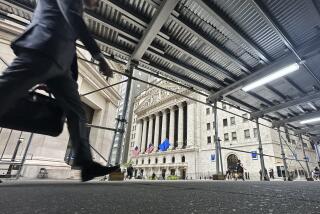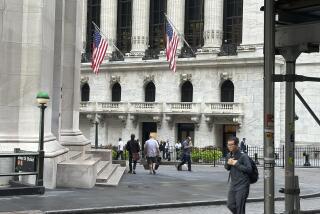Dow Falls 247 in Second-Biggest Point Drop Ever
- Share via
NEW YORK — The Dow Jones industrial average suffered its second-biggest point drop in history Friday, plunging 247.37 points as big consumer company stocks such as Gillette fell on fears that their earnings will slow.
Friday’s slide began after Gillette Co. cautioned analysts that estimates for its earnings might be too high. The news followed a similar warning earlier in the week by Coca-Cola Co. The stock of consumer giant Procter & Gamble Co. also plunged, as investors began to worry that several of the companies that were stalwart leaders of the market on the way up might start to falter.
“For Coke, an icon of the market, to show feet of clay is upsetting,” said Barton Biggs, global equity strategist at Morgan Stanley, Dean Witter, Discover & Co.
The Dow, the most widely followed barometer of stocks, closed at 7694.66. For the week, it was down 336.56 points.
Stock prices have fallen 6.8 percent in the past seven days as investors have lost faith in ever-rising stock prices and begun taking profits. Many market analysts and traders said the downturn is part of a correction--a modest short-term decline in a rising market--that they have anticipated for weeks.
Since April 11, the Dow rose 22% through the end of July. Now the downturn is likely to continue, several analysts said, until investors believe stock prices are more in line with companies’ earnings prospects. Rising interest rates are also hurting the stock market.
“The sentiment has changed despite the non-inflationary numbers this week,” said Matthew Ruane, senior vice president in charge of equity trading at Gerard Klauer Mattison & Co., a New York brokerage firm. “Profits are being taken . . . and I expect it to continue for quite some time. Before, investors were simply shrugging off bad news. But with a slew of bad earnings forecasts in the last few days, prices are so high they’re just not sustainable.”
By any measure, Friday’s drop in the Dow was big, equaling a 3.1% decline. But it pales compared with Black Monday, Oct. 19, 1987, when the blue-chip average plunged 508 points, or 22.61%.
Last week, the Dow closed at an all-time high, reaching 8259.31, and investors and analysts alike were talking stock market nirvana. Now some analysts believe the market could fall 10% before finding its bull legs again. Technically, the market is said to have reached a “correction” when it has declined 10%.
“This is probably the healthiest kind of correction you can get, because there’s no significant economic cause,” said Tim Straus, vice president of institutional research sales at Jefferies & Co. “The blue-chip stocks that were overextended are coming back to reality. It’s long overdue.”
While many analysts were certain the downtrend will continue, no one expressed fear that the market is in a free fall. They stressed that investors shouldn’t be alarmed, but said some people might want to allocate more of their assets to bonds and less to stocks.
“Stocks are still better than bonds; bonds are still better than cash,” said Jeffrey Applegate, chief market strategist for Lehman Brothers Inc. He said he expects stocks to show total returns of 12% over the next year, with bonds returning 9.5% and cash 5%.
The bull market has been like a three-legged table, with strong showings from technology stocks, financial stocks and consumer stocks holding it up, said Steve Shobin, chief technical analyst at Lehman Brothers.
“Now, consumer staples have come unglued,” he said. “When that leadership falters, the rest of the market tends to follow.”
Another factor worrying some investors was the currency markets. Some of the dollar’s strength was sapped in the past two days as investors speculated that Germany might raise interest rates, making the deutsche mark relatively more attractive. And many Asian currencies are facing devaluations.
“What’s happening in Asia is an epidemic devaluing of currencies,” Biggs said. “It’s started to get out of hand all across Asia and means their products will cost less than ours.”
A falling U.S. dollar cools foreign investors’ interest in dollar-denominated stocks because their total returns, as measured by their home currency, will be less.
Program trading, in which a package of stocks are bought or sold simultaneously, also pummeled the market. According to Birinyi Associates, a Greenwich, Conn., research firm, nine selling programs were responsible for 117.24 points of the Dow’s decline.
Interest rates actually ticked down a bit late in the week, with the Treasury’s bellwether 30-year bond yielding 6.54% in late trading Friday. But rates are still higher than earlier this month, when the yield rose to 6.67% over just a few days from a 17-month low of 6.29%.
In the midst of the day’s market storm, Martha Stephens, a member of an investment club in Madison Heights, Mich., and director of corporate services for the National Assn. of Investors Corp., seemed serene.
“It doesn’t make us nervous,” she said of the day’s market activity. “I was talking to my husband yesterday and he said, ‘You know, the market’s at its lowest in a while.’ ” I said, ‘Right. It’s time to buy,’ ” Stephens said. “We’re not talking about $50,000 at a time, but $100 to $200 a month. We’ll just keep putting our money in each month and looking at it as a long-term thing.”
More to Read
Inside the business of entertainment
The Wide Shot brings you news, analysis and insights on everything from streaming wars to production — and what it all means for the future.
You may occasionally receive promotional content from the Los Angeles Times.










